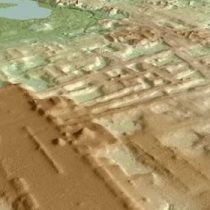
There, in Aguada Fénix, in Tabasco state, a group of scientists recently discovered what is believed to be the oldest monumental construction ever found of the Mayan civilization.
And the largest – so far – in the entire pre-Hispanic history of the region.
The Maya, the fundamental people for Central America that Mexico took to value (despite its enormous importance)
The great Mayan palace of more than 1,000 years that they found in an unexplored area of Mexico
“We went to this area looking for primitive settlements, but we were surprised to find this huge site at this early stage (of the Mayan civilization),” bbc World tells anthropologist Takeshi Inomata, professor at the University of Arizona and leader of the team that made the find.
According to the academic, they had a first indication of the existence of ruins in the place after laser testing on the ground in 2017, although it was not until two years later that they were dazzled by their proportions.
The images began to show an artificial plateau between 10 and 15 meters high and 1,400 meters long and 400 meters wide, giving it a volume greater than that of the Great Pyramid of Giza of Ancient Egypt.
The structure – built with clay, somewhat unusual among the Maya – has nine roads that radiate from its surface and, according to a study published Wednesday in the journal Nature, may have served for the community practice of rituals.
The structure was so large that it looks like a part of the natural landscape.
Research indicates that, after radiocarbon testing, it was determined that it was built between 1,000 and 800 years before Christ, dating it as the oldest Mayan building on record.
And for Inomata and her team it is also one of the first tests that demonstrate the step that this Mayan civilization took from nomadism to a more sedentary lifestyle: the beginning of its Mayan-state cities.
How did they find her?
For some reason unknown, the site was abandoned and nothing was rebuilt on the ground, which over time was covered with forests and even some cattle ranches.
Inomata and his team explored the area where other Mayan constructions were found three years ago, when they located the southern part of the plateau, although they had no idea at the time of their actual proportions.
“This structure was so large that it looks like a part of the natural landscape when you walk on it,” Inomata says.
According to the researcher, archaeologists were first often conducting ground surveys and ground-level mappings to locate lost pre-Columbian settlements. However, this technique took a lot of time and effort.
.
For the detection of this new structure, the team, of which several Mexican experts are part, used a new technology called Light Detection and Ranging (Lidar) that, through lasers, allows to obtain an accurate map of the sites quickly.
“The equipment is placed on an airplane and emits laser beams that penetrate through the treetops. Its reflections allow us to measure the surface of the floor three-dimensionally,” says Inomata.
In the beginning, given its size, the team had no idea what it was about, but once they used the Lidar, “their perfectly rectangular shape became clear.”
One of the objects found
After the discovery, the team conducted excavations in some parts of the structure that revealed several objects that had belonged to civilization and had been hidden for centuries.
Among them, they located several decorative and religious or functional objects, from clay vessels to stones carved with animal shapes.
“We excavated small areas that allowed us to go through the entire sequence of its construction and were able to date its beginning and end,” he tells the academic.
What is the importance of the find?
Other objects found in excavations
For Adriana Velázquez, director of the Mexican National Institute of Archaeology and History in Campeche, this is a “very relevant find” since it offers new contributions on the “early dynamics” of the Mayan civilization.
“It’s an ongoing investigation, it’s just getting started, but I think it can offer very important details about the political organization of the Maya, their conception of the world and their relationship with the Olmecs (another of the cultures that developed during the Preclassic period of Mesoamérica),” he tells BBC World.
The site is located in Tabasco state
According to the expert, the study of Inomata and his team reveals a type of Mayan architecture that was little known, based on clay and not stone, as in its famous constructions in Central America, more traditionally associated with the Olmecs.
“It has generally been thought that the Maya took several lessons on the way of life, architecture and Olmec society, but this discovery makes us wonder that the Maya may have had that knowledge even before they were in contact with the Olmec,” he says.
Inomata, for his part, believes that the find also changes the conception of the way the Maya organized their civilization.
“Traditionally, archaeologists thought social inequality was developing, and then the elite, rulers, or other powerful people organized major construction projects,” he says.
Excavations revealed several objects of the early Mayan civilization
“But Aguada Fénix shows that the great constructions were made in the absence of a powerful elite,” he adds.
According to the expert, although there were probably some leaders who played central roles in the planning and organization of such work, the main factor was the voluntary participation of people in constructions.
“This tells us about the potential of human collaboration that does not necessarily require centralized government,” he says.
Who were the Mayans?
The Maya, who inhabited for nearly two millennia a wide area between Guatemala, southeastern Mexico, Belize and the western part of Honduras and El Salvador, were one of the most developed and mysterious pre-Columbian civilizations.
During their period of heyday, they developed a hieroglyphic writing that was one of the few fully developed writing systems in the pre-Columbian American continent.
The lake that helps solve the mystery of the collapse of the Mayan civilization
What was “the white road” like, the great 100km Mayan highway whose secrets were revealed thanks to digital technology
His art, architecture, mythology, as well as his remarkable numbering systems and his knowledge in astronomy, mathematics and ecology continue to surprise archaeologists and historians over time.
One of the great questions that has been unanswered for centuries was the cause behind the sudden disappearance of such a developed civilization, which some theories have attributed to a strong drought reported between the 800s and 900s of our era.





